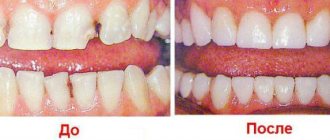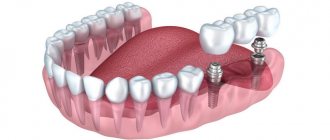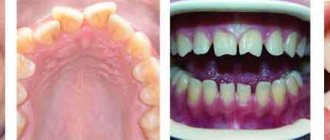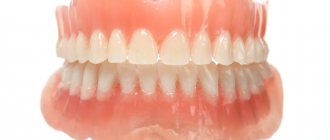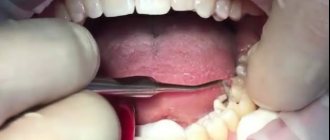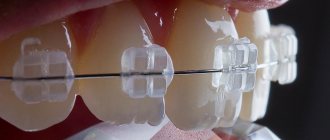01/22/2019 Modern dentistry offers various methods for correcting chips, cracks and other dental defects. One of the popular solutions is extension, which allows you to return the tooth to its original color and shape. What the procedure is and who it is suitable for - you will learn about this from our article.
- What is tooth augmentation?
- Indications and contraindications for the procedure
- Advantages and disadvantages of dental extensions
- Basic methods of filling
- Installation of veneers
- Installation of crowns
- Extension on a pin
Indications and contraindications for tooth augmentation
Teeth augmentation is a multi-stage technology for restoring the aesthetic appearance and functions of the jaw, which was susceptible to chipping or erased as a result of increased tone of the masticatory muscles, called buxism.
Indications for the tooth augmentation procedure:
- chips resulting from injuries;
- numerous caries lesions;
- large distance between teeth;
- wedge-shaped defect;
- the presence of a gap between the two front teeth;
- congenital structural pathologies;
- thinning and demineralization of enamel due to consumption of junk food and lack of oral hygiene;
- cervical caries;
- the presence of errors in previous dental sessions that resulted in the destruction of healthy tissue;
- malocclusion.
Having asked the dentist a question about what tooth extension is called, the patient will immediately hear the answer. The procedure is called dentition restoration. Modern extension technologies make it possible to restore the structure in most cases without resorting to its removal. The procedure is harmless, but has a number of contraindications:
- patient age – more than 60 years;
- children's age when using pins;
- presence of a cyst;
- inflammation of the gums;
- pregnancy in the first or third trimester;
- failure to comply with personal hygiene rules;
- periodontitis and stomatitis;
- jaw fracture and other injuries.
If a patient is diagnosed with diseases that are contraindications, the dentist first treats them, and then restores the dentition.
Correction with crowns
The installation of crowns as tooth extensions is also used in cases where the tooth is not destroyed, but is sufficiently damaged. Installing a crown is one of the effective ways to restore a broken tooth, this applies to both front and chewing teeth. Crowns are also used in cases where it is not possible to fill a chewing tooth, for example, because the cavity left after caries treatment is too large. This type of permanent prosthetics, such as crowns, is an ideal solution in cases where more than 70% of the crown part of the tooth is missing.
In modern aesthetic dentistry, ceramic and metal-ceramic crowns are successfully used. The installation process itself takes place in two stages. First, the doctor prepares the tooth (removes infected tissue, grinds down the walls), then an impression is taken, from which a crown for a chewing tooth or a crown for a front tooth is made in a dental laboratory. The second stage is the fitting and installation of the finished crown. Modern ceramics, used for the manufacture of inlays and crowns, make it possible to perfectly imitate the texture, color and transparency of natural enamel, as well as select a shade in accordance with the color of neighboring teeth.
Teeth extension methods
There are 2 main extension methods:
- Straight. Used if tooth decay is up to 30%. During the procedure, composite or photopolymer materials are used to build teeth. The former are less durable and harden after 30 minutes. The latter have a service life of 10 years and remain plastic until exposed to the lamp.
- Indirect. Applicable when damage affects no more than 70% of the structure. The method has several stages, including taking impressions, making and installing ceramic inlays.
If you have ever thought about whether a crown or extension is better, then you should know that a crown is installed when more than 70% of the tissue is destroyed, but a intact and healthy root remains.
Benefits of restoration
The most important advantage of restoration compared to prosthetics is the absence of pain and surgical intervention. There is no need to cut the gum, build up the bone tissue of the tooth, or wait a long time for the material to engraft. It is possible to restore a tooth even if the crown is completely lost. During one visit to an orthopedic dentist, several incisors can be restored.
The cost of the procedure is much lower than the cost of installing a prosthesis. The service life of composite materials is about seven years. In the future, you can update the extended tooth using the same method. An important advantage of restoration is the ability to restore teeth in hard-to-reach places.
Are there any disadvantages to this method? The main disadvantage is the operating time. If you treat new teeth with care, the composite can last a long time - up to ten years. If you are not careful, the accumulated mass can become deformed within a year. You can no longer eat solid food, and you should also get rid of some habits.
Rules of care
How to brush new teeth, with what toothpastes? In the first days after the procedure, you should refrain from foods and drinks that can stain the surface of the crown. In the future, oral care does not differ from usual. However, patients need to visit their doctor regularly for preventive examinations.
Self-build
Is it possible to build up the missing part of a tooth yourself at home? Unfortunately, this is impossible, just as it is impossible to fill a tooth yourself. However, at home you can strengthen the enamel if it is partially lost or severely abraded. To do this, a remineralization procedure is carried out with special compounds prescribed by the dentist.
Compositions for remineralization:
- special pastes;
- application of aligners and wax matrices;
- protection of enamel with dental varnishes.
Professional dental treatment is also carried out in clinics.
Features of front teeth extensions
Restoration of anterior teeth is carried out in the following cases:
- Yellowing of enamel;
- Damage to caries;
- Minor curvature;
- Presence of chips or chips;
- Grayish-yellow coating.
Composites and photopolymers are used for extensions, but veneers are the most popular. They are used for minor damage to healthy tissue. If the tooth body is deeply damaged, it is removed from the roots and an implant is implanted in its place. Types of veneers presented in our clinic: composite veneers, ceramic veneers.
Chips of baby teeth often occur in childhood. Many parents do not pay attention to this, hoping for the speedy growth of indigenous children. This is wrong, as the sharp edges scratch the tongue, causing inflammation and infection. Children's extensions are made using composite materials and are absolutely painless.
What types of structures are there?
Pins differ depending on the material and type of thread. Let's look at the most popular types of structures used in dentistry:
- Anchor - made of an alloy of gold and platinum or palladium metal. There are active and passive anchor pins. In the first case, the design has a thread, in the second - without thread. The anchor pin is a rod, which is fixed in the root canal. This design provides support for both the microprosthesis and the filling. The advantage of an anchor pin is that it allows you to restore even a severely damaged tooth.
- Titanium – rod structure made of high-strength titanium alloy. This design is fixed in the root canal, often in chewing teeth, since it can withstand heavy loads. Titanium structures are suitable for bulk fillings and even prostheses.
- Fiberglass – Made from high-strength fiberglass. In terms of physical characteristics, glass fiber has similar properties to dentin tissue. Thus, when restoring with a fiberglass pin, the load on the tooth is distributed evenly. Fiberglass is used in medical practice due to its hypoallergenicity and biocompatibility. Another advantage of fiberglass is color. Such structures are colorless or resemble enamel, which is why they are also installed on the front teeth.
- Carbon fiber is the most popular type used in orthopedic dentistry. In structure and physical properties, carbon fiber structures resemble bone tissue. Such pins are characterized by both high strength and elasticity. When installing carbon fiber structures, the likelihood of root and crown fractures is minimized.
- Parapulpal - made of an alloy with stainless metal. Parapulpal structures are rarely used today. They are often installed as additional support for a filling.
Pin structures are also distinguished by shape. Based on this feature, screw, cylindrical, cylindrical-conical and conical structures are distinguished. The shape of the structure is selected depending on the structure of the root canal and the characteristics of the planned treatment.
Roll pins are used when the root strength is sufficient. They provide the patient with sufficient retention. In addition, when selecting, it is important to take into account the diameter. If the diameter of the rod is too small, then during restoration work a gap may form, which can cause the filling to become brittle and lead to infection. If the diameter is too large, there is a risk of root damage.
As for conical forms, when using such structures the risk of root damage is minimal. However, with conical pins, a wedging effect is possible during chewing.
Tooth extension onto a pin
When thinking about whether it is possible to build a tooth onto the root, the use of a pin comes to mind. It is used if both the body and the root are severely damaged.
The procedure includes:
- obtaining an x-ray;
- cleaning the mouth, removing stones;
- removal of damaged areas;
- computer tooth modeling;
- removal of saliva;
- anesthesia;
- cleaning of channels;
- implantation of a pin, cleansing the area around it;
- filling the space around the pin with a composite or photopolymer;
- polishing and grinding.
Dentists build up teeth under crowns only if the remainder is in good condition and does not rot or decompose.
What is a pin
In modern dentistry, various designs are used to recreate damaged teeth.
A pin is one such structure that serves as a support for filling material or a crown. The pin is installed in the root cavity after the nerve is removed. Thanks to this procedure, it is possible to preserve the root, dentition and original structure of the jaw.
The main task of the pin, which is installed on a pulpless tooth, is to evenly distribute chewing pressure. Thus, when chewing, parts of the restored tooth will not experience increased pressure and will not be damaged.
Does it hurt to grow teeth?
Tooth extension is a painless procedure. Anesthesia is not performed if the damage is not significant, since manipulations are carried out at a superficial level. If the damage is severe, the dentist administers local anesthesia. Modern drugs begin to act immediately after administration.
After the session, the first day you may experience pain if the canals were cleaned. Painkillers will help you feel better.
The restored dentition will last a long time if the patient provides proper care. If the question arises about whether it is possible to smoke after tooth extensions, the answer will be negative. Composite and photopolymer materials quickly absorb all substances, which is why the filling quickly changes color. Maintaining hygiene and regular visits to the dentist will help you maintain your smile for a long time.
Reliability and service life
The service life of the extended tooth elements varies quite significantly. Average range: 5 to 20 years. This difference is explained by several factors:
- selected material and extension method,
- individual characteristics of the patient,
- quality of workmanship,
- care of handling.
Systematic preventive visits to the dentist, as well as additional polishing of the tooth surface using specialized drill discs, will help to avoid shrinkage and fading of the composite over time.
When can a tooth be restored?
When the walls have completely crumbled, but the root of the tooth has not been destroyed, traditional dentistry sometimes suggests removing it. Today, using new protocols, it is possible to preserve the root and create a new stable unit - any of the functional ones, except for the “eights” (wisdom teeth). To do this, you need the root to be healthy:
- Not affected by caries, without fractures or cracks. If such defects exist, then only removal followed by implantation is indicated.
- No cyst. If there is one, then a method of treatment is selected. And only then can you begin to restore.
If a similar problem happens to you, do not rush to the surgeon. New technologies make it possible to accomplish the previously impossible - to preserve the root of a tooth. What to do in a particular case is decided at the appointment, after diagnosis. The vast majority of patients manage to save the tooth after treatment procedures and install a crown on the root of the tooth.
Enamel implantation with Innodent
The procedure is new, but has already proven itself as an effective method for restoring tooth enamel .
- Painlessly cures caries in 1 month
- Relieves tooth sensitivity
- Removes white spots after braces
- Strengthens and mineralizes enamel
Description of the procedure:
Innodent is applied to the tooth surface, which in turn is integrated into the enamel structure at the molecular level. This is achieved through active substances whose characteristics coincide with dental tissues.
Main results:
Cracks and damage to the enamel are completely eliminated, the integrity of the tooth enamel is restored and the process of regeneration of the natural structure begins.
When will the results of the procedure be visible?
You will see the first results 3 days after the start of the procedure, but the process of tooth enamel regeneration itself can last 1-1.5 months. A decrease in the sensitivity of enamel to mechanical and temperature stimuli also occurs gradually. In individual cases, it is possible to re-use the drug after 3-4 months.
Indications for the dental enamel implantation procedure
Below we will describe the main indications for which enamel implantation will be the most effective restoration method.
- High sensitivity of teeth (temperature and mechanical)
- Damage (chips) and cracks in tooth enamel
- Wedge-shaped defect (hyperplasia)
- Tendency of teeth to the spread of caries
- Pigment spots on the surface of tooth enamel
- At the initial stage of caries spread
An important feature of the drug is the possibility of use for preventive purposes, as well as in conjunction with teeth whitening procedures. Effectively copes with the treatment of enamel demineralization. It is possible to carry out the procedure after correction with braces in order to eliminate age spots on the surface of the enamel.
Are there any contraindications to the procedure?
The procedure is completely safe and has no contraindications as such. However, in rare cases, the following are possible: an allergic reaction and individual intolerance to one or more components of Innodent. You should not carry out the procedure with major damage to the internal tissues of the tooth.
Pros and cons of dental enamel implantation with Innodent
Main advantages:
- High degree of safety and natural ingredients
- Suitable for pregnant women and children (including baby teeth)
- As a result, you get smooth enamel with a natural shade
- Stains and damage are completely eliminated within a month
- Can be used at the initial stage of caries development and thereby avoid drilling and filling teeth
- Complete painlessness and absence of discomfort for the patient at all stages of the procedure
- The procedure is quick - about 15-25 minutes for everything
- The result lasts really long (from 1 to 3 years)
Flaws:
- Price - the method is not the cheapest, but in terms of price-quality ratio it has no analogues
- Really good results are possible a month after the procedure
- Does not solve the problem with large defects (internal tooth decay)
Dental implantation with the help of Innodent has allowed modern dentistry to truly restore enamel, and not replace it with temporary solutions.
A completely new approach to enamel restoration
Why do tooth remains appear in the gums?
There are many reasons for this phenomenon:
- Perhaps the tooth has completely crumbled, but the root remains.
- The crown received a strong blow and a fracture occurred.
- An incomplete tooth extraction was performed. The remaining fragments cause inflammatory processes in the soft tissues, causing pain.
- Units with the neurovascular bundle removed are often destroyed. The so-called “dead teeth”. The nutrition of their walls is disrupted, the shell becomes fragile and, due to incorrect loading or due to increased fragility, the natural walls break off “at the root.”
If the process has already started, then urgent treatment of the tooth root is necessary. Otherwise, the remains of the unit will have to be removed to avoid infection of adjacent teeth and surrounding tissues.
The situation cannot be ignored: tooth fragments may not bother you at first, but then turn into a serious problem. When trouble occurs, immediately contact the dental clinic to promptly select treatment and find ways to restore the tooth.
Should the tooth root be removed? In what cases is this necessary?
Is it necessary to remove the root of a tooth? The root must be removed if:
- it is mobile, unstable or has a deep pocket;
- there are cracks;
- the root processes are “recessed” into the bone tissue and are located below their level;
- root tissue is softened or severely destroyed;
- There are chips in the tooth root.
Modern surgery is as painless as possible. Doctors perform the procedure while maintaining the integrity of the surrounding tissue. In the absence of inflammatory processes, it is possible to remove the real tooth root with simultaneous implantation of an artificial one.
Deep fluoridation of tooth enamel
Deep fluoridation involves saturating tooth enamel with various minerals that prevent the development of caries. Fluoride-containing substances prevent the destruction of tooth enamel.
Main indications for the procedure:
- To prevent caries
- After installing the filling (to increase its service life)
- High sensitivity of teeth
- General strengthening of tooth enamel
- The need for bleaching and stain removal
- Caries in the active stage
Contraindications:
- Individual intolerance to fluoride-containing components
- Epidemic fluorosis
The procedure is completely safe and painless, but fluoride oversaturation is possible. To avoid this, stop using fluoride-containing medications, including toothpastes, before the procedure.
Main stages of deep fluoridation:
- Complete cleaning of teeth from tartar and plaque (professional cleaning of the oral cavity)
- Using special preparations, the oral cavity is dried with a warm air stream.
- A special sealing agent is applied and dried after a few minutes.
- Teeth shading is carried out - surface treatment of tooth enamel with a solution of copper and calcium hydroxide
Deep fluoridation of tooth enamel is an effective procedure, but its quality is inferior to enamel implantation with Innodent.
